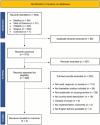Factors That Influence Digital Health Implementation in Rural, Regional, and Remote Australia: An Overview of Reviews and Recommended Strategies
- PMID: 40202368
- PMCID: PMC11980530
- DOI: 10.1111/ajr.70045
Factors That Influence Digital Health Implementation in Rural, Regional, and Remote Australia: An Overview of Reviews and Recommended Strategies
Abstract
Introduction: Digital transformation can enhance health and healthcare delivery; however, its application in rural, regional, and remote (RRR) areas presents considerable, underexplored challenges. While the benefits of digital health for underserved areas are evident, we must understand and address the challenges to fully realise its impact.
Objective: To synthesise the evidence for factors influencing the implementation of digital health in RRR Australia and recommend implementation strategies to address barriers.
Design: An overview of existing reviews was conducted to identify relevant systematic and scoping reviews. Review quality was assessed using the AMSTAR-2 tool. Barriers and enablers to implementation were mapped using the Consolidated Framework for Implementation Research (CFIR), and strategies to address barriers were identified based on the Expert Recommendations for Implementation Change (ERIC).
Findings: Three reviews met the inclusion criteria; each was focused on telehealth and remote monitoring technologies. Influencing factors were identified across five CFIR domains, encompassing 16 barrier and 12 enabler constructs. While gaps in evidence on health outcomes were noted, the benefits of implementation, such as improved access to services, reduced travel, and enhanced patient satisfaction, were highlighted. The recommended implementation strategies involved tailoring interventions to local needs, fostering local leadership and advocacy, planning and structuring implementation, and mobilising resources.
Conclusion: This study identified key influencing factors and recommended implementation strategies to mitigate barriers. These strategies, if employed, could facilitate the successful implementation of digital health in RRR Australia.
Trial registration: PROSPERO CRD42024512742.
Keywords: CFIR; barriers and enablers; digital health innovation; implementation science; rural health services; telehealth.
© 2025 The Author(s). Australian Journal of Rural Health published by John Wiley & Sons Australia, Ltd on behalf of National Rural Health Alliance Ltd.
Conflict of interest statement
Author Leeanna Woods would like to disclose her conflicts of interest, as a guest Editor for this special issue.
Figures



Similar articles
-
Beyond the black stump: rapid reviews of health research issues affecting regional, rural and remote Australia.Med J Aust. 2020 Dec;213 Suppl 11:S3-S32.e1. doi: 10.5694/mja2.50881. Med J Aust. 2020. PMID: 33314144
-
Challenges for remote patient monitoring programs in rural and regional areas: a qualitative study.BMC Health Serv Res. 2025 Mar 13;25(1):374. doi: 10.1186/s12913-025-12427-z. BMC Health Serv Res. 2025. PMID: 40082928 Free PMC article.
-
Patient and provider perspectives on eHealth interventions in Canada and Australia: a scoping review.Rural Remote Health. 2020 Sep;20(3):5754. doi: 10.22605/RRH5754. Epub 2020 Sep 19. Rural Remote Health. 2020. PMID: 32949485
-
Identification of implementation enhancement strategies for national comprehensive care standards using the CFIR-ERIC approach: a qualitative study.BMC Health Serv Res. 2024 Aug 23;24(1):974. doi: 10.1186/s12913-024-11367-4. BMC Health Serv Res. 2024. PMID: 39180022 Free PMC article.
-
Telehealth use in rural and remote health practitioner education: an integrative review.Rural Remote Health. 2022 Jan;22(1):6467. doi: 10.22605/RRH6467. Epub 2022 Jan 17. Rural Remote Health. 2022. PMID: 35038387 Review.
References
-
- Australian Institute of Health and Welfare , Rural and Remote Health (Australian Government, 2024), https://www.aihw.gov.au/reports/rural‐remote‐australians/rural‐and‐remot....
-
- Australian Institute of Health and Welfare , “Health Workforce 2024,” https://www.aihw.gov.au/reports/workforce/health‐workforce.
-
- Badr J., Motulsky A., and Denis J. L., “Digital Health Technologies and Inequalities: A Scoping Review of Potential Impacts and Policy Recommendations,” Health Policy 146 (2024): 105122. - PubMed
-
- Kowatsch T., Otto L., Harperink S., Cotti A., and Schlieter H., “A Design and Evaluation Framework for Digital Health Interventions,” IT‐Information Technology 61, no. 5–6 (2019): 253–263.
Publication types
MeSH terms
Grants and funding
LinkOut - more resources
Full Text Sources
Medical
Miscellaneous

